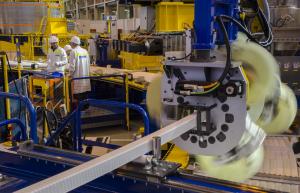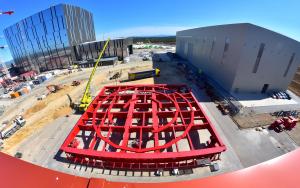The first production double pancake has been placed in a staging area so that additional activities can be carried out (the addition of terminations, the brasing of the intra-pancake joint, and additional insulation) before it passes on to the resin-impregnation phase. In the meantime, back at the winding table, the fabrication of a second double pancake has already started. Before being wound into turns with specific dimensions, the conductor is wrapped with insulating tape.
It takes five layers of fiberglass-kepton bonded tape and a last layer of glass tape at first go; later on, an extra layer of fiberglass will be inserted in between the turns to ensure the "primary insulation" of the double pancake. Resin-impregnation under vacuum (the next fabrication stage) will guarantee the perfect electrical insulation and mechanical resistance of the pancakes and hence, of the whole coil.
In November, a dummy winding will be used to qualify the impregnation tooling and processes before the first impregnation operation is carried out on a "real" double pancake. Elements of twin impregnation stations are being assembled and welded now.




